The Power of Mindset in Aging
“Whether you think you can or think you can’t—you’re right,” said Henry Ford.

NUTRITION

“Whether you think you can or think you can’t—you’re right,” said Henry Ford.

NUTRITION
Good nutrition is one of the building blocks of aging well. It helps support our muscles, bones, and brain and various other body systems, allowing us to remain strong and independent for longer.
But as the years pass, even healthy older adults can experience a loss of appetite and other nutrition-related changes that lead to weight loss, muscle wasting, and nutrient deficiencies. This phenomenon is known as anorexia of aging—and it affects about a quarter of older people.
For caregivers, changes in eating habits can be alarming to witness. But the more you know, the more you can do about it, says Gretchen Dueñas-Tanbonliong, MS, MPH, RDN, Associate Director of Health and Wellness at NCOA. “Understanding the barriers to eating well is the first step in helping the person you care for get adequate nourishment,” she explains.
See NUTRITION on page 6.


SourcePoint is a nonprofit 501(c)(3) organization that provides professional expertise, services, and programs for Delaware County adults who want to thrive after 55, as well as family caregivers. Services and programs are supported by the local senior services levy, private and corporate donations, grants, and the Central Ohio Area Agency on Aging.
2025
President: Pamela Foster, Orange Township
Vice President: Cheri Thompson, Delaware
Secretary: Annie Horstman, MD, Delaware
Treasurer: Dennis Mowrey, Delaware
Randy Bournique, Delaware
Bill Brown, Delaware
Adrienne Corbett, Delaware
Todd Everingham, MBA, Dublin
Ron Fantozzi, Columbus
Beth Fligner, JD, Dublin
Alice Frazier, MD, Delaware
Liz Gitter, MSSW, Delaware
Wren Kruse, JD, New Albany
Beth Long-Higgins, MDiv, Delaware
Michael Tucker, JD, Delaware
Roger Van Sickle, Delaware
Jodie Wegmiller, BSN, MBA, Delaware
The board typically meets the last Wednesday at noon for six months out of the year. Members of the public who wish to attend may call the chief executive officer at 740-363-6677.
My Communicator is published quarterly and is made possible through advertisers, donors, and volunteers. About 5,000 copies of each edition are printed and distributed throughout Delaware County. My Communicator is available for pick-up at SourcePoint and 50 other locations, such as libraries, senior living communities, health care facilities, and other nonprofit organizations. To find a nearby pickup site, contact SourcePoint at 740-363-6677. Read My Communicator online at MySourcePoint.org/publications
To advertise or submit educational content for consideration, contact Chief Advancement Officer Alison Yeager at alison@MySourcePoint.org.
The appearance of advertising does not represent an endorsement by SourcePoint. We reserve the right to refuse any advertising that conflicts with our mission.
The AARP Foundation Tax-Aide program, which provides free tax preparation for older adults at SourcePoint and more than 200 other senior centers, churches, and libraries across Ohio, is looking for volunteer tax preparers for next year.
Tax-Aide volunteers have an immediate and measurable impact on the lives of the people they serve. Volunteers save often financially pressed seniors the cost of paying a private preparer and provide a calm, steady, and reassuring hand in an often stressful situation.
Last tax season, volunteers working at SourcePoint filed 172 federal and state returns, primarily for older adults, saving them an estimated $45,000 in tax preparation fees and enabling them to collect an average refund of nearly $1,600.
Tax-Aide locations across the state were swamped last tax season and had to turn away numerous prospective clients for want of volunteers. Next year, with massive changes in the tax code affecting every senior, demand is going to be even greater.

Anyone who does their own taxes is an ideal candidate for the all-volunteer program. Volunteers receive IRS-approved training, ongoing support, and work on AARP Foundation-provided computers. No one works alone and everyone’s work is double-checked.
Volunteers come from all walks of life, including beauticians, accountants, truck drivers, and managers. Volunteers who prefer not to prepare tax returns are also needed to do such things as manage taxpayer appointments, see that taxpayers have the necessary paperwork, and provide technical support for computers and modems
For more information or to register to volunteer, go to the TaxAide website at aarpfoundation.org/TaxaideVolunteer or call 888-227-7667. Locally, Prospective Volunteer Specialist Judy Gardiner can be reached at ohio2taxaide@gmail.com to answer questions.

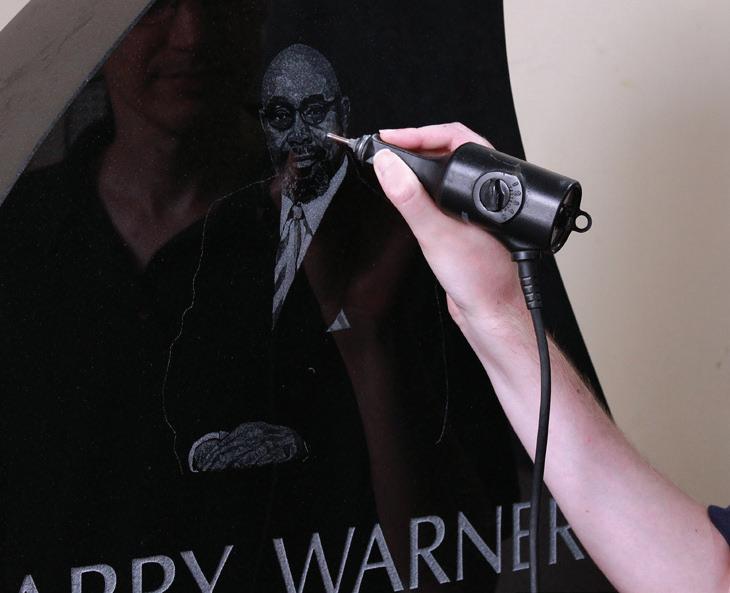



Anxiety is one of the most common human conditions, but when it comes to older adults, it is something that is not talked about enough.
Studies show that the spectrum of anxiety disorders occurring in later life is diverse and includes the same disorders that occur in younger adults, such as generalized anxiety disorder, panic disorder, and social anxiety disorder.
Other neurodegenerative disorders are associated with phobias, such as fear of falling, which is common in older adults. Therefore, accurate diagnosis and treatment in older adults can prove to be complicated and challenging. A geriatric psychiatrist can ensure that the treatment includes providing psychoeducation, psychotherapeutic approaches (e.g., cognitive-behavioral, behavioral, interpersonal, and mindfulness-based psychotherapies), and pharmacotherapy.
Growing older brings many changes and health issues. Many of these changes can lead to anxiety. Studies show that anxiety can present as physical and emotional symptoms. Many people are not aware that physical symptoms can be linked to anxiety. Therefore, it is important to identify symptoms of anxiety as early as possible. See common symptoms of latelife anxiety below:
• Constant worrying: Older adults can often worry, even over simple things, including their health, their children, or about occurrences that are unlikely to happen.
• Sleep-related problems: Older people often experience difficulty in falling asleep or staying asleep. Even if
they sleep, they may wake up tired. Anxiety can affect brain activity and keep it active even at night.
• Physical symptoms: In older ages, the heart beats faster. Elders may often feel dizzy. Stomach problems or headaches are common symptoms connected to anxiety. These symptoms can confuse people as they mimic other illnesses.
• Restlessness: Older adults may feel nervous for no reason. They may also become angry or irritated easily. This can be a result of underlying stress.
• Avoiding activities: Many older adults with anxiety avoid social gatherings and going out. They may not want to meet new people and they may avoid getting involved in things they once loved, which can lead to more loneliness and sadness.
• Difficulty in concentrating: Older adults often forget things or feel as if their minds are cloudy and confused. Anxiety and stress can make it hard to focus even on simple tasks.
Other symptoms of anxiety that are commonly observed in older age are mentioned below:
1. Emotional symptoms of anxiety include:
• excessive and irrational worrying
• inability to relax
• difficulty concentrating
• feeling tense or jumpy
• irritability or restlessness
• sleep-related problems
2. Physical symptoms may include:
• headaches
• fatigue
• trembling
• racing heart
• sweating
• muscle tension
• light-headedness
• shortness of breath
• gastrointestinal discomfort
Early diagnosis and treatment for late-life anxiety can help prevent the condition from worsening and improve overall quality of life. It also reduces the risk of related issues like depression, sleep problems and physical health decline.
Cognitive behavioral therapy (CBT) is a type of talk therapy that can help people identify and change negative thought patterns. It is safe and effective for older adults. It helps them to manage worry and gain control over their mind.
Medication: Healthcare providers may prescribe medications if required. Usually, antidepressants and anti-anxiety medications are prescribed to manage symptoms. But these need to be taken with caution, especially in older adults who may be taking medications for other health conditions.
‘Even a daily 20-minute walk can make a big difference in one’s mental state.’
Mindfulness practice: Deep-breathing exercises and meditation practice can help relax the mind. Meditation practice reduces stress and anxiety. Relaxation techniques and meditation practice are safe and can be done daily. Many older
people feel calmer and more relaxed with these practices.
Support groups: Healthcare providers often recommend joining a support group, as talking to others who feel the same can help in the healing process. Support groups or community gatherings help in reducing loneliness and help elders to feel supported and safe. It reminds them that they are not alone.
Daily physical activity: Exercises like walking or stretching help in releasing endorphins that promote happiness. This can help older people improve their bodies and minds. Even a daily 20-minute walk can make a big difference in one’s mental state.
Family support: Healthcare providers also can educate family members regarding anxiety in older adults, because when
family members understand the condition, they are better able to support it.
If you notice these symptoms in someone you love or work with, do not ignore them. Support and encourage them to consult a mental health provider.
Below are some ways to prevent late-life anxiety:
• Eating a well-balanced diet
• Limiting alcohol and caffeinated drinks
• Getting adequate sleep
• Scheduling time for relaxing activities
• Avoiding events or situations that make one more anxious
• Exercising regularly
Late-life anxiety is not just a part of aging; it is a health issue that can be treated
and managed. With the right help and support, the condition can get better. Therefore, early diagnosis and treatment are important for timely interventions and better outcomes.
Source: American Society on Aging. Read more at asaging.org.
Wednesday, Nov. 12, 1–2 p.m. at SourcePoint
Join National Alliance on Mental Illness speakers and grandparents, Tracie Bayer and Ginny Bischert for this onehour presentation for adults, specifically grandparents, with middle or high school aged grandchildren. This presentation includes mental health warning signs, facts and statistics, how to talk with your grandchild and how to work with school staff. This presentation will be helpful for anyone interested in mental health of youth, discussing what middle and high school students experience, and how to best help them.
Wednesday, Dec. 10, 1–2 p.m. at SourcePoint
Ron Graham and Tracie Bayer from the National Alliance on Mental Illness will present a powerful and personal program on understanding life with mental illness. Through real-life experiences, they will explore three key themes:
• What Happened – their personal journeys and challenges.
• What Helps – strategies, resources, and support that make a difference.
• What’s Next – moving forward with hope and resilience. This presentation is open to everyone and offers an honest, insightful look into the realities of living with mental illness. Don’t miss this opportunity to learn, connect, and gain a deeper understanding through firsthand stories.
From page 1
Let’s look at four common nutrition challenges older adults face and practical ways you can help as a caregiver.
What are common nutritional problems in aging adults?
1. Taste changes and loss of appetite
What we experience as “flavor” is actually a mix of several basic tastes (salty, sweet, sour, savory, and bitter) combined with the smell of food and the sensations of temperature and texture. As we age, our sense of taste and smell may be blunted. This can make foods seem bland and unappealing, which in turn reduces the drive to eat. What’s more, certain medications—such as those for blood pressure, depression, and allergies—can further dull taste perception.
On top of this, declines in physical activity and metabolic rate can cause older adults to feel less hungry and consume fewer calories.
mealtimes. It also gives your care recipient a sense of control over decisions that affect them. That’s important, since loss of independence is a common concern as we get older.
2. Dental issues and difficulty chewing or swallowing
Oral health problems—including tooth loss, ill-fitting dentures, and dry mouth—tend to make chewing painful or difficult. Medical conditions like Alzheimer’s disease and Parkinson’s disease can lead to dysphagia (difficulty swallowing), a syndrome affecting 10% to 33% of older adults.

What caregivers can do when taste changes or loss of appetite happens
Plan regular mealtimes and snacks, which helps our bodies trigger hunger signals. Try spacing meals further apart to stimulate appetite.
Alternatively, try smaller, more frequent meals. This can feel less overwhelming to some people and make digestion more comfortable.
Help your care recipient add movement into every day. Exercise burns calories, which naturally boosts sensations of hunger. It can also improve digestion and metabolism and even elevate mood.
Enhance foods naturally with different spices and fresh herbs like thyme, dill, and rosemary. Add garlic, lemon, hot pepper, mustard, and vinegar to foods to improve taste without relying on excessive salt.
Incorporate nostalgic or favorite foods that evoke pleasant memories and spark interest in eating. Blending vibrant colors (e.g., fruits and vegetables) with different textures can also make meals more enticing.
Invite the person to take an active role in planning and/or preparing meals. This can help them feel more excited about
Any of these physical issues can increase the risk of choking or cause a person to avoid healthy foods like fruits, vegetables, and meats. Worse, they turn mealtimes into a source of stress and fear.
What caregivers can do for dental issues and difficulty chewing or swallowing
Encourage regular dental checkups and ensure dentures fit well.
Offer soft, moist foods like soups, stews, casseroles, mashed vegetables, yogurt, and smoothies.
Cut foods into small, manageable pieces or puree meals when needed.
Introduce oral nutrition supplements (ONS) such as nutritional drinks and shakes to boost calorie and nutrient intake, especially when chewing is a struggle or your care recipient is sensitive to certain textures. These beverages provide critical micro and macro nutrients while being easy to consume. According to Aimee Henrikson, MPH, RD, Senior Manager of Medical Affairs for Nestle’s BOOST®, protein is one of the nutrients many older adults fall short on—and that impacts muscle health. For caregivers who need help identifying how much protein their care recipient needs, there are simple online tools, including a protein calculator from Nestle, that provide an estimate of recommended protein intake based on a few basic inputs.
Offer hydrating foods like cucumbers, watermelon, and brothbased soups to help manage dry mouth while providing essential fluids.
Mouth moisteners (in the form of sprays, mouthwashes, or lozenges) can serve as saliva substitutes for adults who have dry mouth. Sugar-free chewing gum helps stimulate salivary production in between meals.
If swallowing is a concern, reach out to a speech therapist or registered dietitian to learn about safe eating strategies.
3. Chronic illnesses and medication side effects
Roughly 9 in 10 older Americans report having one or more chronic conditions like obesity, high blood pressure, high cholesterol, and diabetes. These conditions often come with dietary restrictions that limit food choices.
At the same time, medications used to treat chronic conditions can have side effects like nausea, dry mouth, constipation, and reduced appetite. Certain drugs may also affect nutrient absorption (e.g., diuretics, laxatives, ACE inhibitors).
Together, these factors can make it difficult to know what foods are safe and nutritious. Some older adults may eat less as a result, or avoid entire food groups altogether, setting the stage for nutrient deficiencies.
What caregivers can do about chronic illnesses and medication side effects
Talk to your care recipient’s physician or a registered dietitian nutritionist (RDN) to build a flexible meal plan tailored to that person’s medical condition or other health needs.
Is the person on medications known to interfere with nutrient absorption? Ask their doctor or pharmacist about a diet that keeps them well-nourished while ensuring their medicine stays safe and effective.
Watch for any side effects when your care recipient is starting or changing medications (and report them to their provider).
Prioritize nutrient-dense foods such as eggs, nut butters, beans, fish, avocados, and whole grains. These provide energy and key nutrients, even in smaller servings.
Keep meals balanced yet flexible. This helps ensure the person feels comfortable but not overly restricted in their food choices.
4. Social and psychological barriers to healthy eating
Social isolation, grief, and mental health disorders like anxiety and depression can all affect an older person’s desire to eat. Others may face practical challenges like limited mobility, a tight budget, or lack of help with grocery shopping or daily meal preparation. These factors can lead to skipped meals or overreliance on unhealthy convenience foods.
What caregivers can do about social and psychological barriers to healthy eating
Whenever possible, encourage shared meals with family and friends to make eating more enjoyable. Contact your care recipient’s local area agency on aging to ask about congregate
meal programs, where older adults can dine together out in the community.
If the person has trouble preparing food, look into homedelivered meal programs (e.g., Meals on Wheels). Online grocery delivery services are another option for having fresh food brought right to their door. Oral nutritional supplements can help fill nutritional gaps when food intake is reduced.
Set up a pleasant, calming mealtime environment by playing soft music, using attractive plates, and turning off distractions like the TV.
Is your care recipient showing signs of depression such as hopelessness, loss of interest in eating and other activities, or sleep issues? Talk to their doctor about therapy and other treatment options.
If social isolation is a factor for the person you care for, contact their area agency on aging and ask about senior support services.
While aging can present nutritional obstacles for some older adults, they’re not insurmountable. The key is to stay vigilant for warning signs—such as unexplained weight loss, fatigue and muscle weakness, or avoidance of certain foods—and take steps to get ahead of them.
Dueñas-Tanbonliong points out that caregivers are major influencers in health and wellness. “Your impact is powerful. You can help that person find new joy and connection in mealtimes while getting the nutrition they need to live their best life.”.
Source: National Council on Aging. Read more at ncoa.org.







From page 1
When it comes to aging well, behavioral science increasingly points to a powerful and often overlooked starting point: mindset. This isn’t simply motivation or willpower, but the beliefs we hold about what is possible as we grow older.
We often hope to exact behavior changes via education: if we teach people what to eat or why exercise is essential, they will eat better and move more. But for many older adults, the real barriers aren’t knowledge gaps—they are belief systems. What we believe about aging can profoundly shape how we age.
Psychologist Carol Dweck, PhD, in 1988 introduced the concept of the growth mindset to describe the belief that abilities can be developed through effort and learning. Though her early work focused on education, this framework has powerful implications for aging. If older adults believe their health, mobility or memory is fixed and inevitably headed for decline, they are far less likely to engage in healthy behavior change.
Yale researcher Becca Levy, PhD, has demonstrated that our perspective on aging isn’t just philosophical, but has tangible consequences for health and longevity. In a groundbreaking study, Levy found that older adults who held more positive views about aging lived, on average, 7.5 years longer than those with more negative beliefs.
A decade later, her research showed that people with positive age beliefs were 44% more likely to recover from severe disability. A recent study of older adults with mild cognitive impairment found that those with positive age beliefs were 30% more likely to regain cognitive function
and also recovered nearly two years sooner than their peers who held negative perceptions of aging.
‘Age beliefs, it turns out, are a form of psychological infrastructure. They are foundational to our navigation of the world.’
Other researchers have affirmed Dr. Levy’s findings. In 2023, a comprehensive meta-analysis of 107 longitudinal studies confirmed that subjective age (how old one feels) and positive self-perceptions of aging are associated with better health and longer life across diverse global populations. Age beliefs, it turns out, are a form of psychological infrastructure. They are foundational to our navigation of the world.
What gets in the way of having a positive mindset about aging? As a gerontologist working closely with older adults, I have identified two common, invisible mindset barriers that undermine behavior change in older adults before it even begins.
1. The first is internalized ageism. Cultural messages like, “It’s too late,” “Why bother?,” or “This is just what happens at my age,” become embedded in selftalk. Even older adults who are highly motivated may quietly believe that change is no longer possible or worthwhile.
2. The second is the tendency for public health messaging to emphasize decline. Campaigns often focus on what older adults are at risk for (e.g., falls, memory loss, frailty), rather than what they can gain through healthy habits. While the intent may be prevention, the effect can be disempowering. When aging is framed primarily in terms of loss, people may begin to expect it. By contrast, hope-based messaging supports a sense of agency and
possibility, and it is from that mindset that meaningful change begins.
The good news is that mindsets can shift. In coaching programs and community health settings, older adults can build confidence when they are exposed to stories of resilience, encouraged to challenge limiting beliefs, and supported by peers. One such model is Open Source Wellness (OSW), a nonprofit organization that provides group-based behavioral health coaching grounded in lifestyle medicine principles. OSW integrates health coaching with social connection and peer support to make healthy change feel possible and joyful.
Reframing aging doesn’t require dramatic reinvention. Sometimes it begins with a simple question: “What if there’s still more in me?” That question is quietly radical, and professionals can help older adults ask it.
To support healthy aging, our initial focus shouldn’t be on new behaviors but on new beliefs. That means:
• Naming and challenging internalized ageism
• Elevating real-life stories of late-life growth
• Including growth mindset conversations in coaching, care planning, and public messaging
• Framing healthy aging as potential, not just prevention
Aging is not a problem to be solved. It is a process to be lived, with agency, dignity and ongoing possibility. Believing that change is possible is the first step toward making it a reality.
Source: American Society on Aging. Read more at asaging.org.
Being able to see and hear well is important for good balance. Poor vision and hearing loss can increase the risk of falls. Here are five easy actions you can take today to make sure your eyes and ears are helping you reduce your risk of falling.
1. Get an eye exam every year. Remember to have a dilated eye exam once a year to update your glasses and to detect eye diseases, like cataracts and glaucoma. Early detection and treatment can help protect vision and prevent vision loss and falls.
2. Wear glasses properly. Use prescribed glasses and avoid wearing sunglasses inside.
3. Be safe while wearing bifocals: Bifocals can make your vision blurry when navigating steps, curbs, or edges, especially while outside. If you wear bifocals, tuck your chin in when stepping over curbs and on stairs to look through the distance portion of your glasses, which provides a clearer view. Or wear single vision glasses while outside and on stairs while inside.
4. Check for hearing changes. Get a hearing test once a year and receive treatment if any hearing loss is identified. Hearing tests are available online, and hearing aids for mild to moderate hearing loss are sold over-the-counter in retail stores and pharmacies.
5. Light it up! Add a nightlight in the bedroom, bathroom, and hallway to help you navigate in the dark and find the light switch.
Between 2014 and 2023, the U.S. population of people 65 and older increased by 28%, and in 2023, the number of people 65 and older killed in traffic crashes made up 19% of all traffic fatalities. During Older Driver Safety Awareness Week Dec. 1–5, 2025, we remind you that simply getting older doesn’t mean it’s time to hang up your keys—but you should evaluate how you drive.
According to the SAFE Delaware County Coalition, the number of people 65 and older killed in traffic crashes made up 33% of all traffic fatalities in Delaware County in 2023. In other words, of the 15 killed in 2023, five were older adults and four of those were the driver in error.
Medical

Many vehicles can be modified to accommodate an older driver’s specific needs by adding adaptive equipment. This equipment can be as simple as a swivel seat for more convenient access, a hand control to make it easier to operate a vehicle, or a pedal extender. Make sure to ask a qualified mobility dealer for training on how to use the equipment.
Each year, vehicle manufacturers release new and improved driver assistance technologies to help keep road users safer. The technologies include everything from automatic emergency braking to blind spot intervention and lane keeping assistance. Driver assistance technologies aren’t just about keeping drivers safe; they also keep pedestrians and other road users safe.
As people age, it’s important to monitor changes in overall health as it relates to driving. While some drivers can safely drive into their nineties, for others medical conditions, problems with eyesight, sleep, tremors, or memory can make driving more difficult and dangerous.
Ask yourself:
• Can you remember the routes you often drive?
• Do traffic signs and signals or other drivers make you feel overwhelmed while driving?
• Have you recently received a ticket or citation for a driving violation, or been in a minor crash?
Medications
Many older people take multiple medications, whether prescribed or over-the-counter. Unfortunately, some of these drugs or a combination of drugs can impair judgment, or affect reflexes or the alertness necessary for safe driving. An older driver’s primary care provider or pharmacist can help determine if an older driver’s medications can affect their driving.
NHTSA offers free educational resources for older drivers and older drivers’ caretakers to help make sure everyone can enjoy their later years to the fullest. We, and our many partners from the American Occupational Therapy Association, AARP, AAA, CDC and Association for Driver Rehabilitation Specialists, encourage drivers and their families to begin a “transportation plan,” much like what many are encouraged to do for retirement.
The SAFE Delaware County Coalition invites all drivers to participate in older driver safety programs at SourcePoint and to contact coordinator Jackie Bain for additional information on how to keep you driving longer safely at jbain@delawarehealth.org or 740-203-2083.
Roundabouts are becoming a familiar sight in Delaware County — and for good reason. The Federal Highway Administration reports that nationally, roundabouts reduce fatal and injury crashes by 82% compared to two-way stops, and by 78% compared to intersections with traffic signals.
Recently, Katie Wright, Safety Engineer with the Ohio Department of Transportation, led a 90-minute class* at SourcePoint explaining why roundabouts are safer, the laws that govern their use, and practical strategies for driving them with confidence.
“A roundabout is a mindful intersection,” says Jackie Bain, community health specialist with the Delaware Public Health District. They require drivers to slow down, pay attention, and yield appropriately.
Within the next few years, Delaware County plans to add at least 25 more roundabouts. Locations are chosen based on traffic patterns and where serious or fatal crashes have occurred.
1. Slow down as you approach.
2. Check signs for lane guidance—typically posted to your right or overhead.
3. Yield to pedestrians and traffic already in the roundabout.
4. Travel counterclockwise—always.
5. Don’t change lanes in a multilane roundabout. If you’re in the wrong lane, exit and re-enter safely.
*Missed the ODOT Class? Here’s How to Catch Up!
• Explore ODOT’s online roundabout resources—including printable safety guides—at transportation.ohio.gov/aboutus/basics/roundabouts.
• Visit the Delaware County Engineer’s website for videos, diagrams, and more safety tips at engineer.co.delaware. oh.us/design/roundabouts
Jodie Kaminsky is SourcePoint’s community aging planner and oversees the Age-Friendly Delaware County initiative.
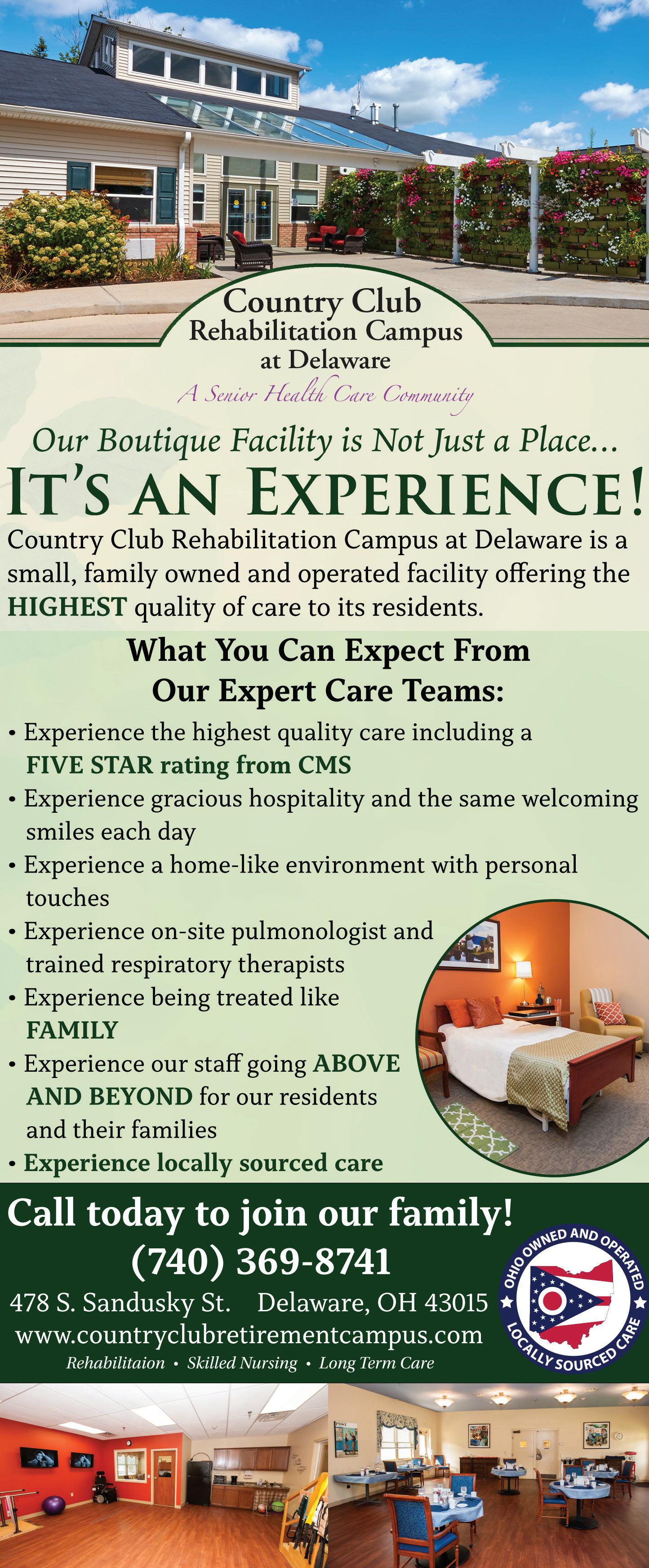
Can you actually show up for yourself like you show up for others? Caregiving involves a whirlwind of emotions and adjustments, and often the stages of caregiving involve confusion and frustration as well as realization and acceptance.
The Rose of Jericho is a plant used differently in cultures all over the world. At first look, the plant appears gray and dry, as if nearing death. However, the power of the plant shows up the moment it is submerged in water, springing back to life.
Whether you’re an experienced caregiver or a newly minted one, know that every caregiving situation is unique and should be assessed on its own terms because what worked in one situation may not work in another. And as you navigate challenging times in your caregiver journey, you might feel depleted and tired like the Rose of Jericho—but you, too, can spring back.
With so many things to juggle and such a complex, winding road ahead of you, it
can be easy to wear ourselves out when trying to support those around us.
In order for you to show up as a caregiver, friend, or spouse for someone else, selfcare is necessary for avoiding burnout and exhaustion. Checking on these basic parts of life will help you meet your cognitive needs. Take 5 minutes to check in on yourself with these questions.
Taking care of yourself as a caregiver: 4 questions to ask to avoid burnout
1. Am I thirsty or hungry? Hydration and food are important to our physical well-being, which affects our mental health, too. Drinking plenty of water is a simple yet vital part of maintaining good health, especially as we get older, and eating healthy ensures you get adequate nutrients.
2. Do I feel safe? Safety is a fundamental need we all have. Once safety is compromised, we may feel unbalanced without realizing it.
Take charge of your Medicare decisions with this comprehensive, two-part workshop designed to educate and empower. Fourth quarter classes are Saturday, Nov. 1, Dec. 6, or Jan. 3, from 9 a.m. to noon at SourcePoint.
Learn more and register for free at MySourcePoint.org/insurance
Questions? Call 740-363-6677.
3. Do I need rest? Unhealthy sleep can interfere with daily activities and is associated with lower quality of life and risk of chronic disease. Adults should get seven to nine hours of sleep per night, but about 1 in 3 of us report not getting enough rest. Sleep restores our energy and is an oft-overlooked option for helping us manage our days.
4. Do I need to breathe? Allow yourself to take three deep breaths—make them the deepest you’ve taken all day. Remind yourself we inhale life and exhale exhaustion.
Checking on these basic parts of life will help you meet your cognitive needs. In order for you to show up as a caregiver, friend, or spouse for someone else, selfcare is necessary for avoiding burnout and exhaustion. With these simple questions, you can build resilience and strength, like the Rose of Jericho after touching water.
Source: National Council on Aging. Read more at ncoa.org.

SourcePoint is proud to mark a landmark anniversary: CEO Fara Waugh’s 30th year with the nonprofit organization. This November, the community is invited to join in 30 Years of Impact, 30 Days of Gratitude—a month-long celebration that honors Fara’s milestone while highlighting the lives touched by SourcePoint’s mission.
For three decades, Fara has worked alongside a dedicated team of staff, volunteers, and community partners to expand programs and services that make aging at home possible. Meals on Wheels, in-home care, caregiver support, and enrichment programs have grown and flourished under her leadership, serving as lifelines to thousands of older adults in Delaware County.
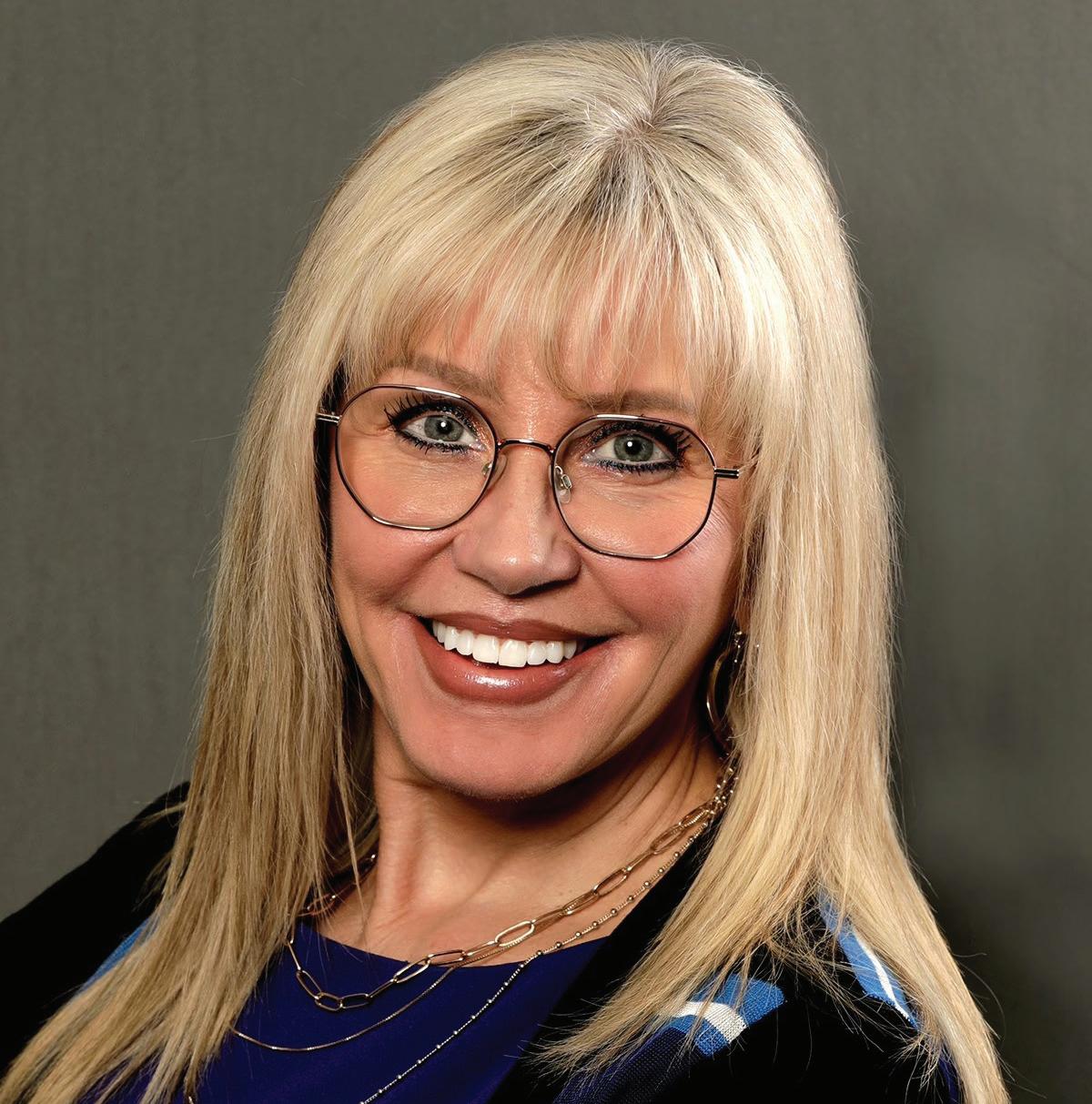
of Fara’s 30 years, $300 for greater impact, or any meaningful amount. Contributions ensure the continued success of programs that promote independence, healthy aging, and well-being.
Throughout the month, SourcePoint will share stories of resilience, gratitude, and impact—from older adults whose lives have been transformed, to the staff and volunteers who make that transformation possible. Special features on social media will highlight memorable milestones and heartfelt reflections from across the community.
“This celebration is about more than one leader,” said Pamela Foster, SourcePoint’s board president. “It’s about the clients who rely on SourcePoint every day, those who participate in daily community programs, and the staff and volunteers who bring our mission to life. Fara’s steady leadership has helped create a community where older adults are valued, supported, and connected.”
The 30 Days of Gratitude campaign invites community members to honor this legacy through gifts that directly support local aging services. Suggested donations include $30 in recognition
Community members are encouraged to join the celebration, honor Fara’s 30 years of service, and invest in the future of aging services in Delaware County. This initiative is part of SourcePoint’s annual campaign, held each year in November and December.
To contribute or learn more, visit MySourcePoint.org/give or follow SourcePoint on Facebook and Instagram.
SourcePoint is a nonprofit 501(c)(3) organization that provides professional expertise, services, and programs for Delaware County adults who want to thrive after 55, as well as family caregivers. Services and programs are supported by the local senior services levy, private and corporate donations, grants, and the Central Ohio Area Agency on Aging.
The latest news, programs, and resources available at SourcePoint.
DROP-IN OPTIONS NEW!
ComPASS members may now drop in for the fitness center or exercise classes on days they visit without prior registration. To drop in, members must:
1. Confirm available openings with Customer Service.
2. Pay the $5 drop-in fee.
FLEX AND FLOW
Mondays with Judy H., 4–4:45 p.m.
Beginner-advanced. Improve your flexibility and mobility with this full-body range-of-motion workout. We’ll use a combination of seated and standing movements that will improve core strength, stability, balance, and flexibility. A fun and friendly class for all fitness levels.
Fee: $50 for the series.
RESISTANCE TRAINING
Mondays or Fridays with Jennifer, noon‒12:45 p.m.
Beginner-advanced. This class demystifies resistance/ strength training by teaching you the ‘how’ behind the exercise and equipment. Use dumbbells and bodyweight to help you achieve your goals.
Fee: $50 for a one-time per week series.
AQUA STRETCH & FLOW NEW!
Mondays with Dyan, 3:15‒4 p.m.
Intermediate-advanced. Take your aquatics class to a whole new level using water weights to increase your strength and balance, and intervals to pump up your heart rate, improve fitness, and increase metabolism.
Fee: $50 for a one-time per week series.
WILD WATER FITNESS NEW!
Tuesdays with Donna, 9:15‒10 a.m. or 10:15‒11 a.m.
Intermediate. Get wild in this fun fitness class that’s gentle on your joints and muscles. Enjoy classic oldies music while boosting your aerobic fitness and building muscular strength and endurance with water weights and noodles. It’s a feelgood class at your own pace where you’re sure to have a wild time getting fit!
Fee: $50 for a one-time per week series.
DRIVER SAFETY: WE NEED TO TALK WORKSHOP
COMMUNITY DISCUSSION
Thursday, Nov. 6, 4:30–6:30 p.m.
The SAFE Delaware County Coalition, Delaware Public Health District, and Age-Friendly Delaware County partner to offer a two-hour workshop on talking about driving safety with an older adult. The difficult discussion concerning whether the older adult should transition from driver to passenger will be addressed using elements from an AARP seminar that offers practical tips and advice. This interactive workshop will consist of four 20-minute sessions addressing the meaning of driving to older adults; observing driving skills; recognizing warning signs; and planning alternatives to driving.
HEALING WITH HORSES: A CAREGIVER RESPITE EVENT NEW!
Tuesday, Oct. 21, 1–3 p.m. or Thursday, Nov. 20, 1–3 p.m. at Stockhands Horses for Healing, 3788 Olentangy River Road, Delaware.
Join us at Stockhands Horses for Healing for a two-hour restorative experience created for respite for caregivers. This event offers a peaceful setting for caregivers to step away from daily demands and participate in activities to focus on reconnecting with themselves as they connect with horses and other caregivers. To ensure a respite opportunity, separate activities focused on creating meaningful experience for care-receivers will be available.
Caregivers are welcome to attend with or without care receivers. Registration is needed for both caregivers and care-receivers who intend to participate. You can register up to two participants with each registration.
DOWNSIZING SERIES START TO FINISH NEW!
Wednesday, Oct. 15 and Mondays, Nov. 17 and Dec. 15, 10–11 a.m.
Caring Transitions franchise owner Justin Issacson offers practical guidance and emotional support for older adults and their families facing major life transitions. Topics include decluttering and organizing your home, preparing to move, selling or donating personal belongings, and adjusting to a smaller living space. Learn how to approach these changes with confidence, reduce stress, and make thoughtful decisions that honor your memories while simplifying your lifestyle. Issacson is not affiliated with or endorsed by SourcePoint.
Oct 15: Downsizing–Where to Start Nov. 17: The Paper Diet Dec. 15: Estate and Online Sales Fee: $5 for series.
ACRYLIC PAINTING: BIRDS ON A WIRE NEW!
Monday Oct. 13, 10:30 a.m.–12:30 p.m.
Create a painted masterpiece! Perfect for all skill levels, this class guides you step-by-step to paint adorable birds perched on a wire, with plenty of room for creativity and personal flair. Led by Anne Vasser or Imani Burke. Fee: $20.
PIANO: BEGINNER
Saturdays, Oct. 11 through Nov. 15, 9–10 a.m.
Learn the basics of piano with musician Kathleen Mergler using the Faber and Faber, Primer Level books (Amazon). Purchase books ahead of time or see how class goes. Bring your keyboard if you have one. Fee: $60 for six-week series.
SKETCH CLASSES: BEGINNER NEW!
Mondays, Oct. 6 and 20, 10 a.m.–noon. Learn how to draw realistically. We’ll explore basic shapes and shading to figure drawing, perspective, and creative sketching techniques. Come ready to experiment, make mistakes, and have fun! Please bring your own sketchbook and pencil set. Led by Victoria Carmina. Fee: $20 for the series.
FRIENDSGIVING LUNCHEON
Friday, Nov. 21, 11 a.m.–1:30 p.m.
Our fall quarter luncheon celebrates the magic of relationships. The talented kitchen staff will create a feast to enjoy with friends. Also, stop by our photo booth to get some pics with your besties. For Delaware County Residents ages 55 and better, lunch is available on a donation basis upon completion of proper paperwork. For non-residents and those younger than 55, lunch is $8. Sponsored by Ohio Living Sarah Moore.
GANDHI MOVIE SCREENING PLUS Q&A COMMUNITY EVENT
Tuesday, Oct. 7, 4–7:45 p.m.
An acclaimed masterpiece, GANDHI depicts the life of Mohandas Gandhi, the beloved leader of India who led the people of India in the first of a kind non-violent struggle to obtain freedom from the British empire and set India free. GANDHI is an intriguing story about activism, politics, religious tolerance and freedom. Winner of 8 Academy awards including Best Picture, Best Director (Richard Attenborough) and Best Actor (Ben Kingsley). The movie will be screened on Oct. 7, 4–7 p.m. After the movie screening, there will be a discussion and Question/ Answer session conducted by GANDHI MEMORIAL SOCIETY, Columbus. Please feel free to bring your own dinner/snack and drink.
BALLETMET’s “THE NUTCRACKER” NEW!
Wednesday, Dec. 17; estimated timing: 6:15 p.m. bus departure, 10:45 p.m. return.
Step into a world of holiday magic with BalletMet’s timeless production of The Nutcracker. This beloved classic takes the audience on a whimsical journey with Clara, the Nutcracker Prince, and a host of enchanting characters. Don’t miss the chance to experience the joy of The Nutcracker through the Land of Snow and the courts of the Sugar Plum Fairy this holiday season at the Ohio Theatre in Columbus.
Activity Level 1.
Registration through Nov. 5.
Fee: $75 for members; $95 for nonmembers.
Most people tend to focus on one type of exercise or activity and think they’re doing enough. Research has shown that it’s important to get all three types: aerobic, muscle-strengthening, and balance.
Doing one type of exercise can help improve your ability to do the others, and variety helps reduce boredom and risk of injury. There are also activities that incorporate multiple types of exercise, such as yoga, dancing, or water aerobics.
For workout videos and examples of how to do some of the exercises listed below, visit NIA’s YouTube channel. No matter your age, you can find activities that meet your fitness level and needs and help improve your overall health!
Aerobic exercises for older adults
Sometimes referred to as endurance or cardio, aerobic physical activity involves moving the body’s large muscles for extended periods of time. This requires the lungs to move more air and the heart to pump more blood and deliver it to the working muscles. Aerobic physical activity increases your breathing and heart rate.
Being physically active in this way—with consistency over time—will improve your endurance and the health of your lungs, heart, and circulatory system. It can also help lower the risk of many diseases that are common in older adults, such as diabetes, certain cancers, and heart disease.
Gradually build up to at least 150 minutes of moderate-intensity aerobic activity (such as brisk walking) each week. If
exercising with chronic conditions makes it hard to get the recommended amount of activity, talk with your doctor about what you can do. In general, it’s a good idea to be as physically active as you can—even light-intensity movement can be beneficial. Try to be active throughout your day and avoid sitting for long periods of time.
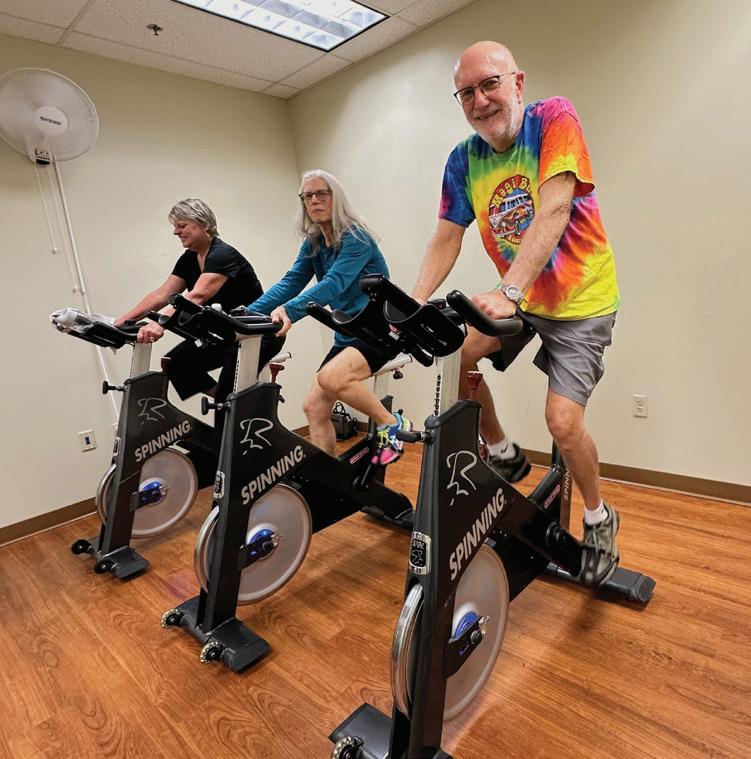
To prevent injuries, use safety equipment, such as a helmet when bicycling, and proper exercise shoes and clothes.
Talk with your doctor if you are unsure about a particular activity.
Quick tip: Test your exercise intensity
Examples of moderate-intensity activities that build endurance include:
• Yard work, such as raking leaves or pushing a lawnmower
• Housework, such as mopping or vacuuming
• Dancing
• Swimming
• Bicycling
• Climbing stairs or hills
• Playing pickleball
Safety tips
Listen to your body. Aerobic activities should not cause dizziness, chest pain or pressure, or nausea.
Do a little light activity, such as easy walking, before and after your aerobic activities to warm up and cool down.
Be sure to drink water when doing any activity that makes you sweat. If your doctor has told you to limit your fluids, be sure to check before increasing the amount of fluid you drink while exercising.
If you are going to be exercising outdoors, be aware of the weather and your surroundings.
When you’re being active, try talking. If you’re breathing hard but can still have a conversation easily, it’s likely moderateintensity activity. If you can only say a few words before you have to take a breath, it’s vigorous-intensity activity, such as running or jogging. Building up to 75 minutes of vigorous-intensity activity or doing a combination of both moderateand vigorous-activity can also count toward your aerobic exercise goal.
Muscle-strengthening exercises, sometimes called strength training or resistance training, are activities that require the muscles to contract, often to lift a heavy object against the pull of gravity. Gradual increases in the amount of weight, number of sets or repetitions, or the number of days a week of exercise will result in stronger muscles.
Muscle-strengthening activities improve physical function and can help you stay independent and make it easier to perform everyday activities, such as getting up from a chair, climbing stairs, and carrying groceries. This type of
exercise is also key to maintaining existing strength, slowing the loss of muscle mass, and helping to prevent falls and fallrelated injuries.
Try doing muscle-strengthening activities at least two days per week to work the major muscle groups of the body (muscles of the legs, hips, chest, back, abdomen, shoulders, and arms), but avoid working the same muscle group on any two days in a row to allow for muscle recovery between sessions.
The exercises should involve at least a moderate level of intensity or effort and be performed to the point at which it would be difficult to do another repetition. One set of eight to 12 repetitions of each exercise is effective, although two or three sets may be more effective. If you are a beginner, try exercises without weights or resistance bands (stretchy elastic bands that come in varying strengths) until you are comfortable with the movements.
Examples of muscle-strengthening activities include:
• Using resistance bands, weight machines, or hand-held weights
• Lifting your body weight, with exercises such as arm circles, leg raises, pushups, pullups, planks, squats, or lunges
• Carrying heavy items, such as groceries
• Gardening, which may require digging and lifting
Listen to your body. Overdoing musclestrengthening exercises can cause exhaustion, sore joints, and muscle pain or injury.
Warm up for muscle-strengthening activity by doing exercises with less weight. Don’t hold your breath during strength exercises — breathe out during the effort and breathe in as you relax.
Avoid “locking” your arm and leg joints in a straight position.
If you are unsure about doing a particular movement, seek guidance from your doctor or physical therapist.
Consider scheduling a session or two with a personal trainer or look for a group class at a local gym, recreation center, or senior center to learn proper form. Free online videos demonstrating specific strength exercises can also help.
Flexibility is the ability of a joint to move through the full range of motion. Stretching can help maintain and improve flexibility. Moving more freely will also make it easier for you to exercise and perform activities of daily life, such as reaching down to tie your shoes or unloading the dishwasher. Stretch when your muscles are warmed up...
See EXERCISE on page 21.
It started with a high school typing course.
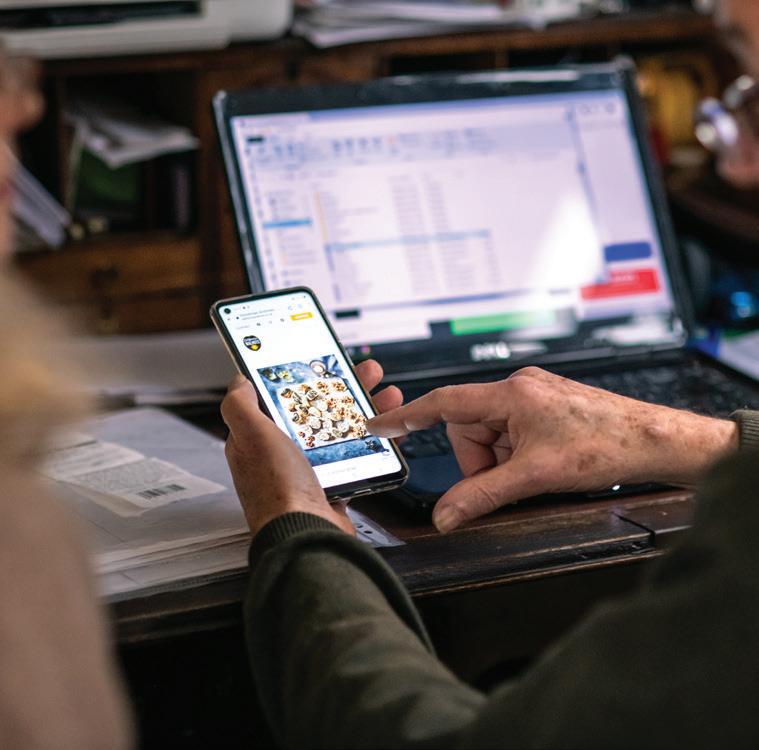
Wanda Woods enrolled because her father advised that typing proficiency would lead to jobs. Sure enough, the federal Environmental Protection Agency hired her as an after-school worker while she was still a junior.
Her supervisor “sat me down and put me on a machine called a word processor,” Woods, now 67, recalled. “It was big and bulky and used magnetic cards to store information. I thought, ‘I kinda like this.’”
Decades later, she was still liking it. In 2012—the first year that more than half of Americans 65 and older were internet users—she started a computer training business.
Now she is an instructor with Senior Planet in Denver, an AARP-supported effort to help older people learn and stay abreast of technology. Woods has no plans to retire. Staying involved with tech “keeps me in the know, too,” she said.
Some neuroscientists researching the effects of technology on older adults are inclined to agree. The first cohort of seniors to have contended—not always enthusiastically—with a digital society has reached the age when cognitive impairment becomes more common.
Given decades of alarms about technology’s threats to our brains and well-being—sometimes called “digital
dementia”—one might expect to start seeing negative effects.
The opposite appears true. “Among the digital pioneer generation, use of everyday digital technology has been associated with reduced risk of cognitive impairment and dementia,” said Michael Scullin, a cognitive neuroscientist at Baylor University.
It’s almost akin to hearing from a nutritionist that bacon is good for you.
“It flips the script that technology is always bad,” said Murali Doraiswamy, director of the Neurocognitive Disorders Program at Duke University, who was not involved with the study. “It’s refreshing and provocative and poses a hypothesis that deserves further research.”
Scullin and Jared Benge, a neuropsychologist at the University of Texas at Austin, were co-authors of a recent analysis investigating the effects of technology use on people over 50 (average age: 69).
They found that those who used computers, smartphones, the internet, or a mix did better on cognitive tests, with lower rates of cognitive impairment or dementia diagnoses, than those who avoided technology or used it less often.
“Normally, you see a lot of variability across studies,” Scullin said. But in this analysis of 57 studies involving more than 411,000 seniors, published in
Nature Human Behavior, almost 90% of the studies found that technology had a protective cognitive effect.
Much of the apprehension about technology and cognition arose from research on children, sometimes focused on adolescents, whose brains are still developing.
“There’s pretty compelling data that difficulties can emerge with attention or mental health or behavioral problems” when young people are overexposed to screens and digital devices, Scullin said.
Older adults’ brains are also malleable, but less so. And those who began grappling with technology in midlife had already learned “foundational abilities and skills,” Scullin said.
Then, to participate in a swiftly evolving society, they had to learn a lot more.
Years of online brain-training experiments lasting a few weeks or months have produced varying results. Often, they improve a person’s ability to perform the task in question without enhancing other skills.
“I tend to be pretty skeptical” of their benefit, said Walter Boot, a psychologist at the Center on Aging and Behavioral Research at Weill Cornell Medicine.
“Cognition is really hard to change.”
The new analysis, however, reflects “technology use in the wild,” he said, with adults “having to adapt to a rapidly changing technological environment” over several decades. He found the study’s conclusions “plausible.”
Analyses like this can’t determine causality. Does technology improve older people’s cognition, or do people with low cognitive ability avoid technology? Is tech adoption just a proxy for enough wealth to buy a laptop?
“We still don’t know if it’s chicken or egg,” Doraiswamy said.
Yet when Scullin and Benge accounted for health, education, socioeconomic status, and other demographic variables, they still found significantly higher cognitive ability among older digital technology users.
What might explain the apparent connection?
“These devices represent complex new challenges,” Scullin said. “If you don’t give up on them, if you push through the frustration, you’re engaging in the same challenges that studies have shown to be cognitively beneficial.”
Even handling the constant updates, the troubleshooting, and the sometimes maddening new operating systems might prove advantageous. “Having to relearn something is another positive mental challenge,” he said.
Still, digital technology may also protect brain health by fostering social connections, known to help stave off cognitive decline. Or its reminders and prompts could partially compensate for memory loss, as Scullin and Benge found in a smartphone study, while apps help preserve functional abilities like shopping and banking.
Numerous studies have shown that while the number of people with dementia is increasing as the population ages, the proportion of older adults who develop dementia
has been falling in the United States and several European countries.
Researchers have attributed the decline to a variety of factors, including reduced smoking, higher education levels, and better blood pressure treatments. Possibly, Doraiswamy said, engaging with technology has been part of the pattern.
Of course, digital technologies present risks, too. Online fraud and scams often target older adults, and while they are less apt to report fraud losses than younger people, the amounts they lose are much higher, according to the Federal Trade Commission. Disinformation poses its own hazards.
And as with users of any age, more is not necessarily better.
“If you’re bingeing Netflix 10 hours a day, you may lose social connections,” Doraiswamy pointed out. Technology, he noted, cannot “substitute for other brain-healthy activities” like exercising and eating sensibly.
An unanswered question: Will this supposed benefit extend to subsequent generations, digital natives more comfortable with the technology their grandparents often labored over? “The technology is not static — it still changes,” Boot said. “So maybe it’s not a one-time effect.”
Still, the change tech has wrought “follows a pattern,” he added. “A new technology gets introduced, and there’s a kind of panic.”
From television and video games to the latest and perhaps scariest development, artificial intelligence, “a lot of it is an overblown initial reaction,” he said. “Then, over time, we see it’s not so bad and may actually have benefits.”
Like most people her age, Woods grew up in an analog world of paper checks and paper maps. But as she moved from one employer to another through the ’80s and ’90s, she progressed to IBM desktops and mastered Lotus 1-2-3 and Windows 3.1.
Along the way, her personal life turned digital, too: a home desktop when her sons needed one for school, a cellphone after she and her husband couldn’t summon help for a roadside flat, a smartwatch to track her steps.
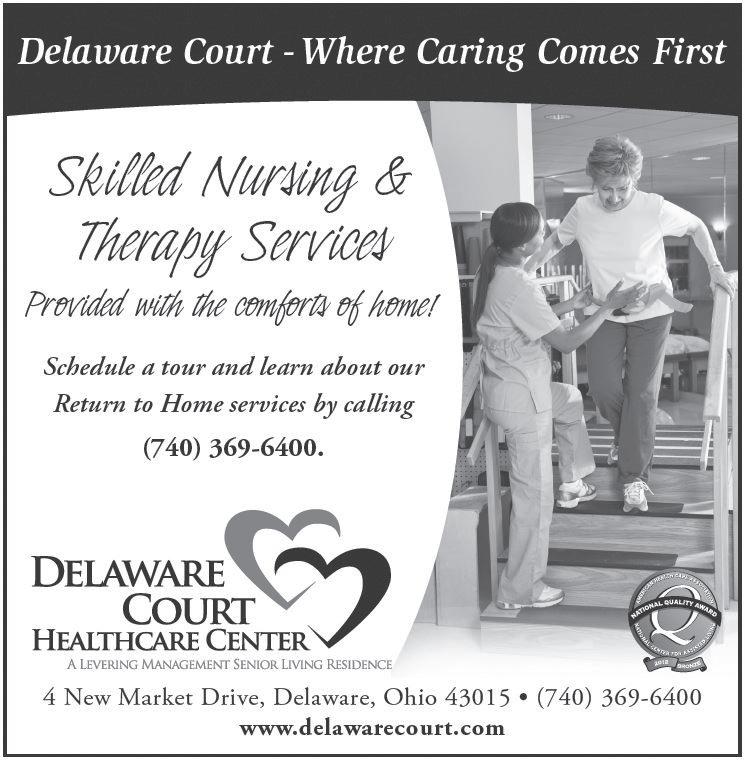
These days, Woods pays bills and shops online, uses a digital calendar, and grouptexts her relatives. And she seems unafraid of AI, the most earthshaking new tech.
Last year, Woods turned to AI chatbots like Google Gemini and OpenAI’s ChatGPT to plan an RV excursion to South Carolina. Now, she’s using them to arrange a family cruise celebrating her 50th wedding anniversary.
Source: KFF Health News. Read more at kffhealthnews.org.
This creamy and savory pumpkin hummus is festive for the month of October! This hummus is sure to be a favorite among family and friends. Garnish with chopped rosemary, pomegranate seeds, and toasted pumpkin seeds for extra flavor.
Ingredients (serves 8)
15 oz can chickpeas, drained & rinsed
15 oz can pumpkin purée (not pumpkin pie filling!)
2 cloves of fresh garlic, minced or grated
1/2 lemon, juiced
1/3 cup tahini
1 tablespoon pure maple syrup
1 teaspoon kosher salt
1 teaspoon ground cumin
3/4 teaspoon ground cinnamon
1 dash of cayenne pepper (optional)
1/4 cup olive oil
1/4 cup ice water
Garnish (optional): rosemary, pomegranate seeds, pumpkin seeds
Preparation
1. Add chickpeas, pumpkin purée, and garlic to the bowl of the food processor and pulse a few times to break everything up into small pieces.
2. Add lemon juice, tahini, maple syrup, kosher salt, cumin, cinnamon, and cayenne pepper (optional).
3. Turn the food processor on LOW.
4. With the food processor running, slowly stream in the olive oil while the food processor runs for 2-3 minutes. The hummus should appear chunky.
5. With the food processor still running on LOW, slowly add ice water 1 tablespoon at a time until the hummus becomes smooth and reaches the desired consistency.
6. Transfer to a serving bowl and serve with an extra drizzle of olive oil, a sprinkle of chopped rosemary, toasted pumpkin seeds, and/or pomegranate seeds.
7. Serve with whole grain pita chips, sliced apples, carrots, or root veggie chips. Enjoy!
Source: Community Servings. Read more at servings.org
Macaroni and cheese has been a scrumptious staple on many dinner tables. If looking for a healthier version of this dish that doesn’t skimp on deliciousness, try using butternut squash.
Ingredients (serves 8)
1 whole butternut squash (about 1 pound), cut in half lengthwise and seeds scooped out
2 tablespoons olive oil
1 ½ cups low sodium vegetable broth, divided
½ teaspoon onion powder
½ teaspoon garlic powder
½ teaspoon black pepper
10 ounces whole wheat elbow pasta
1 medium shallot, minced
2 cups skim milk
3/4 cup cheddar cheese, shredded
1 teaspoon salt
¼ cup panko breadcrumbs
2 tablespoons freshly grated Parmesan cheese
Chopped chives for garnish (optional)
Preparation
1. Preheat oven to 375° F. Spray a 9” x 11” glass baking dish with nonstick spray and set aside.
2. Place two squash halves onto a baking sheet, cut side up. Brush each with olive oil.
3. Bake squash for about 40 minutes or until soft and fork tender.
4. Scoop out the flesh into a mixing bowl. Add ½ cup vegetable broth, onion powder, garlic powder, and ½ teaspoon black pepper. Blend until smooth and creamy.
5. Cook pasta according to package directions. When cooked, drain and put back into the pot.
6. Add shallots and olive oil to medium saucepan and sauté 2 minutes.
7. Add the remaining 1 cup broth and milk to saucepan and whisk to combine. Bring sauce to a boil, then reduce heat to medium-low and cook 5 minutes, whisking frequently.
8. Remove saucepan from heat and whisk in cheese, squash mixture, 1 teaspoon salt, and a few pinches of pepper
9. Add sauce to noodles, gently mix to combine, then transfer mixture to prepared baking dish.
10. Combine breadcrumbs and Parmesan into small bowl. Sprinkle mixture over dish and bake 25 minutes.
From page 17
...and after endurance or strength exercises, remember to breathe, and don’t stretch so far that it hurts.
Balance exercises for older adults
Balance involves maintaining the body’s stability while still or in motion. As with muscle-strengthening exercises, balance exercises help to prevent falls and fall-related injuries. Aim for about three sessions of balance exercises a week.
Examples of balance exercises include:
• Tai chi (a “moving meditation” that involves shifting the body slowly, gently, and precisely, while breathing deeply)
• Yoga
• Standing on one foot
• The heel-to-toe walk
• The balance walk
• Walking backward or sideways
• Practicing standing from a sitting position
• Using a wobble board
Safety tips
Listen to your body. If you feel unsteady, take action to steady yourself.
Go slowly and mindfully to prevent falling.
If you are unsure about doing a particular movement, seek guidance from your doctor or physical therapist.
Have a sturdy chair, person, or wall nearby to hold onto for support.
Wear comfortable, stable footwear or go barefoot to have grip on the floor or mat.
Combining the three types of physical activity
Older adults need a mix of physical activities to stay healthy. As part of your weekly activity, include a combination of aerobic, muscle-strengthening, and balance activities.
You can also combine more than one type of exercise into the same exercise session. Activities such as dancing, yoga, tai chi, gardening, or sports can also be considered a combination because they often incorporate multiple types of physical activity.
Source: National Institutes of Health. Read more at newsinhealth. nih.gov.
See Sudoku Solutions on page 23.
This article contains little tidbits of information collected from many of the discussions I’ve had with you.
Your computer, smartphone, and/or tablet can make reading web content more like reading a book. If your web browser app (Chrome, Safari, Firefox, Edge, etc.) has a “reader” option, you can use it to remove a lot of the clutter from the web content. On Microsoft Edge, it is called “Immersive Reader.” On Mozilla Firefox, it is called “Reader View.” Apple Safari simply calls it “Reader.” Google Chrome calls it “Reading Mode.” Sometimes the reader option is shown as a little icon on the right side of the browser window, but sometimes it is hidden (like in Google Chrome). It doesn’t help with apps like Amazon or Facebook, but is more likely to work with news or web search pages.
Google Maps and Bing Maps can show you the traffic before you leave the house. These map websites can display different layers. As an example, they can show satellite images that include buildings, terrain, roads, etc., as you would see them from high above. One of the layers will show traffic. The roads will be green for no traffic delays, yellow for some slow spots, and red for high traffic congestion or closures. Just move through the map
following the route you intend to take and see what traffic issues you may face.
You can look up when your smartphone will be out of support. The most important date is when it will no longer receive security updates. The website called “endoflife-date” (endoflife.date) lists the key dates for all kinds of tech. It shows when the device is no longer receiving operating system (OS) updates, security updates, the last OS version it can run, and other dates. Another place to check key dates is the manufacturer’s web pages. Apple, Samsung, Amazon Kindle, Google, and most major manufacturers will list support dates on their websites.
The USPS can tell you what is coming in your mail. This online service lets you know when mail was delivered, saving you a trip to the mailbox if there’s nothing there to collect. The app is called Informed Delivery and is available on the USPS website. The address for the website is usps.com/manage/informed-delivery.htm. To enroll, go to the website and complete the form. You will be sent emails showing you a scan of the mail to be delivered and an email when it is delivered. You can also receive emails regarding packages arriving in the USPS mail.
You can check out eBooks, audiobooks, movies, etc. from the library using your tablet or smartphone. Libby is an app that allows you to check out library eBooks, audiobooks, etc. for 21 days. You will need a library card from one of the libraries available, and you can usually do that online at the web address of the library. Libby is an app you can install on your Apple or Android devices. You can also use it on a Windows or Apple PC. Amazon Kindle readers will also work with Libby. It will help you find the book you want by title, genre, and/or author.
Jarren Ringle is a member of SourcePoint and a volunteer instructor. SourcePointers come to Jarren for tutelage on their tablets, laptops, and the most popular of all devices – cell phones. He teaches various technology classes throughout the year including one-on-one sessions and group classes. Jarren also volunteers at the Delaware County Office of Homeland Security and Emergency Management. With many years of project management experience in various technology fields, he enjoys helping others with technology.
Technology 1:1 Assistance: Jarren Ringle provides guidance on technology in a 45-minute time slot. Do you have questions regarding a cell phone, PC, laptop, or tablet? Share what the device is and what your question is upon registration so that Jarren can be better prepared to help. Register at MySourcePoint.org/register.
SourcePoint,
Aging Services Caregiver Support
Falls Prevention & Safety Health & Wellness
Medicare Education Nutrition Volunteering

Headaches come in many forms. Where you feel the pain, what other symptoms you have, and how long headaches last can vary. For many people, headaches are an occasional nuisance. For others, they can be chronic and disabling.
Some headaches can be prevented with small lifestyle changes.
Drinking enough water, avoiding headache triggers, managing stress, or improving sleep can sometimes be enough. Other headaches may require more intensive interventions.

NIH researchers are working to develop more options for people who aren’t helped by current treatments.
There are many types of headaches. Understanding the type you’re having can help you find the right treatment.
The most common is called a tension-type headache. These are often triggered by stress, which causes muscles in the neck, face, scalp, and jaw to tighten. Lack of sleep, dehydration, and poor posture can also lead to a tension-type headache.
The pain from a tension-type headache is usually mild to moderate and can be felt on both sides of the head. Some people have chronic tension-type headaches. These happen frequently and can last for hours to days, or even constantly.
“We define chronic headache as having more than 15 headache days per month. So, more days with headache than not,” says Dr. Michael Oshinsky, a pain expert at NIH.
Other common headaches are those caused by migraine. Migraine isn’t just a headache. It’s a complex brain condition. Migraine headaches often occur on one side of the head. But they can also be on both sides. Migraine attacks can include nausea, vomiting, mood changes, extreme tiredness, and sensitivity to light, noise, and smells. Attacks can last for hours to days.
“Migraine is a disorder where the ‘volume knob’ of the nervous system has been turned up,” explains Dr. K.C. Brennan, a migraine researcher at the University of Utah. “In people with chronic migraine, it stays turned up.”
There are many other types of headaches. One that causes extremely painful, sudden attacks is the cluster headache. These attacks can happen around the same time each day or every other day for several weeks.
Some people, such as combat veterans, live with post-traumatic headaches. These are headaches that linger after a traumatic brain injury or a concussion. They can last long after the injury is healed. Other, rarer types of headaches can be caused by nerve problems in the head area.
Headaches can also be caused by other health conditions. Brain injury, stroke, seizures, infections, high blood pressure, and other conditions can all lead to headaches. These are called secondary headaches.
If you have headaches that disrupt your daily life, talk with your doctor. They can help you find relief or refer you to a specialist.
Some headaches may indicate a dangerous medical problem that needs immediate medical attention.
You can help take control of your headaches by keeping a headache diary. Track your symptoms, how often they happen, and what alleviates them.
“For at least a month, just note down when you have a headache, how you treated it, how long it lasted,” Oshinsky says. You can also include facts like foods or drinks consumed, sleep patterns, stress levels, and changes in daily routines. This can help you identify what might have triggered the headaches so you can work to avoid them. Sharing your diary with your doctor can help them better understand the type of headaches you’re having and suggest a treatment plan.
Over-the-counter pain relievers can help some people with occasional headache pain. Others may need prescription drugs.
But frequently taking painkillers for headaches may make things worse, Oshinsky explains. “If you use painkillers more than three or four times a week, once the drug is out of your system you can get a rebound headache,” he says.
People with frequent or chronic headaches can try preventive treatments. These stop headaches from starting, rather than dulling the pain once they start. For example, a type of medication called CGRP drugs helps many people with migraine have fewer attacks.
But the available preventive treatments don’t work for everyone. Researchers are looking for other ways to stop headaches from forming.
Brennan’s team is studying a compound called glutamate. Glutamate is important for normal brain function and helps nerve cells communicate. But Brennan’s team has found that it may sometimes also play a role in triggering migraines.
“We need to figure out how this unusual glutamate activity works, in what brain cell type, and under what conditions, in order to develop a more tailored approach to migraine treatment,” he says.
Other treatments for headaches don’t involve drugs at all. Some people get relief with a type of talk therapy called cognitive-behavioral therapy, or CBT. This includes learning coping strategies and ways to think differently about pain.
“There are changes in the brain after doing CBT, just like there are changes in the brain after using medications,” says Dr. Hadas Nahman-Averbuch, who studies migraine pain at Washington University in St. Louis. Other people find relief using mind-body techniques such as mindfulness practice or biofeedback, she adds.
Source: News in Health, a monthly newsletter from the National Institutes of Health, part of the U.S. Department of Health and Human Services. Read more at newsinhealth.nih.gov.



SourcePoint frequently partners with the Delaware County Foundation, including raising funds for our own endowment. If you’re considering leaving a planned gift, the Foundation’s staff can help you navigate the process.

Honor Our Veterans at the 16th Annual
Tuesday, Nov. 11, 2025
Delaware County Fairgrounds Agriculture Center 236 Pennsylvania Ave., Delaware Breakfast begins at 8:30 a.m.
Presented by the Delaware County Veterans Association
Presentation on the USS Squalus and the Diving Bell Veteran of the Year and Friend of the Veterans Awards
Breakfast is free for veterans plus one guest.
Seating is limited and reservations are required. Register online at MySourcePoint.org/veterans by Nov. 1.
Questions? Contact Sara Freeman, SourcePoint’s community events specialist, at 740-203-2357 or sfreeman@MySourcePoint.org.
PROUDLY